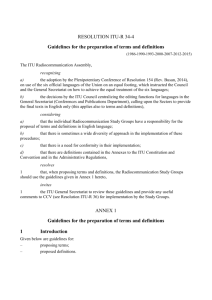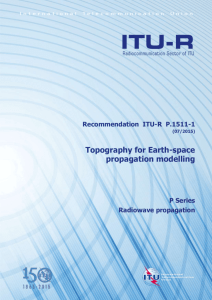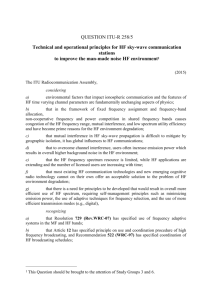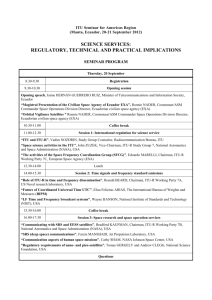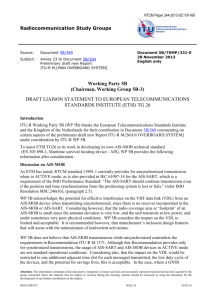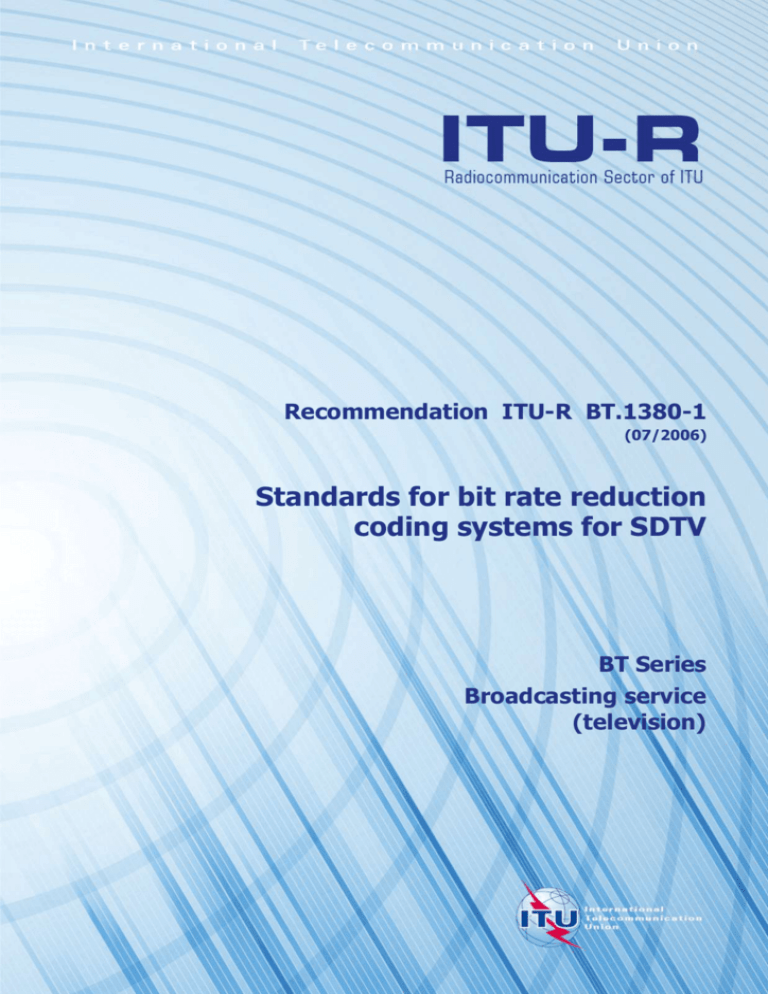
Recommendation ITU-R BT.1380-1
(07/2006)
Standards for bit rate reduction
coding systems for SDTV
BT Series
Broadcasting service
(television)
ii
Rec. ITU-R BT.1380-1
Foreword
The role of the Radiocommunication Sector is to ensure the rational, equitable, efficient and economical use of the
radio-frequency spectrum by all radiocommunication services, including satellite services, and carry out studies without
limit of frequency range on the basis of which Recommendations are adopted.
The regulatory and policy functions of the Radiocommunication Sector are performed by World and Regional
Radiocommunication Conferences and Radiocommunication Assemblies supported by Study Groups.
Policy on Intellectual Property Right (IPR)
ITU-R policy on IPR is described in the Common Patent Policy for ITU-T/ITU-R/ISO/IEC referenced in Annex 1 of
Resolution ITU-R 1. Forms to be used for the submission of patent statements and licensing declarations by patent
holders are available from http://www.itu.int/ITU-R/go/patents/en where the Guidelines for Implementation of the
Common Patent Policy for ITU-T/ITU-R/ISO/IEC and the ITU-R patent information database can also be found.
Series of ITU-R Recommendations
(Also available online at http://www.itu.int/publ/R-REC/en)
Series
BO
BR
BS
BT
F
M
P
RA
RS
S
SA
SF
SM
SNG
TF
V
Title
Satellite delivery
Recording for production, archival and play-out; film for television
Broadcasting service (sound)
Broadcasting service (television)
Fixed service
Mobile, radiodetermination, amateur and related satellite services
Radiowave propagation
Radio astronomy
Remote sensing systems
Fixed-satellite service
Space applications and meteorology
Frequency sharing and coordination between fixed-satellite and fixed service systems
Spectrum management
Satellite news gathering
Time signals and frequency standards emissions
Vocabulary and related subjects
Note: This ITU-R Recommendation was approved in English under the procedure detailed in Resolution ITU-R 1.
Electronic Publication
Geneva, 2011
ITU 2011
All rights reserved. No part of this publication may be reproduced, by any means whatsoever, without written permission of ITU.
Rec. ITU-R BT.1380-1
1
RECOMMENDATION ITU-R BT.1380-1
Standards for bit rate reduction coding systems for SDTV*, **
(Question ITU-R 12/6)
(1998-2006)
Scope
This Recommendation covers the use of ITU-T Recommendations H.262 (MPEG-2 Video) and
H.264 (MPEG-4 AVC) as a choice of the video source coding schemes for a series of SDTV
broadcasting applications.
The ITU Radiocommunication Assembly,
considering
a)
that rapid progress is being made in bit rate reduction coding techniques;
b)
that bit rate reduction coding of digital SDTV signals has found wide applications for
emission by terrestrial means and by satellite, for SNG1/ENG2, for contribution, for both primary
and secondary distribution by telecommunication networks and by cable networks;
c)
that a number of Radiocommunication Groups are studying the uses of bit rate reduction
coding in the various applications;
d)
that ITU-R Recommendations on user requirements have been established for emission by
terrestrial means and by satellite, for contribution, for both primary and secondary distribution by
telecommunication networks and by cable networks;
e)
that Recommendation ITU-R BT.1203 for user requirements for generic bit rate reduction
coding for an end-to-end television system (SNG/ENG, contribution, primary and secondary
distribution, emission and related applications) has been established;
f)
that ITU-T Recommendation H.264 (MPEG-4 AVC) offers a broader compression toolkit
and a more efficient compression than ITU-T Recommendation H.262 (MPEG-2 Video), and that
for certain applications it may provide a superior choice since it offers a greater pixel depth, over
the one offered by ITU-T H.262, as well as improved coding efficiency,
*
In this Recommendation the acronym SDTV refers to signals based on Recommendation ITU-R BT.601
(Part A).
**
Radiocommunication Study Group 6 made editorial amendments to this Recommendation in
October 2010 in accordance with Resolution ITU-R 1.
1
The definition of satellite news gathering (SNG) can be found in Annex 1 § 1.1 of Recommendation
ITU-R SNG.770 .
2
The definition of electronic news gathering (ENG) can be found in Annex 3 § 2 of Recommendation
ITU-R SA.1154 and § 3 of Report ITU-R BT.2069.
2
Rec. ITU-R BT.1380-1
recommends
1
that for the use of ITU-T Recommendation H.262, the following profiles and levels should
preferably be used respectively for SNG/ENG, contribution, studio production, primary and
secondary distribution and for the emission of SDTV signals by terrestrial and satellite delivery;
SNG/ENG
Contribution
Studio
production
Primary
distribution
MP@ML
422P@ML(1)
422P@ML(2) 422P@ML(1)
Terrestrial
emission
Satellite
emission
Secondary
distribution
MP@ML
MP@ML
MP@ML
NOTE 1: For studio production, DV-based coding(3) may also be used.
(1)
Taken from ITU-T Recommendation J.89.
(2)
Bit rate limited to 50 Mbit/s, taken from Recommendation ITU-R BR.1376.
(3)
Bit rate limited to 25 Mbit/s either for 4:2:0 or for 4:1:1 sampling structure and at 50 Mbit/s for 4:2:2
sampling structure, taken from Recommendation ITU-R BR.1376.
2
that for the use of ITU-T Recommendation H.264, the following profiles and levels should
preferably be used respectively for SNG/ENG, contribution, studio production, primary and
secondary distribution and for the emission of SDTV signals by terrestrial and satellite delivery;
(1)
SNG/ENG
Contribution
Studio
production
Primary
distribution
Terrestrial
emission
Satellite
emission
Secondary
distribution
Level 3/
high 10
Level 3/
high 4:2:2
Level 3/
high 4:2:2
Level 3/
high 4:2:2
Level 3/
main(1)
Level 3/
main
Level 3/
main
Some administrations have already selected this main profile for this application.
NOTE 1 – The choice between ITU-T Recommendation H.262 or ITU-T Recommendation H.264
for the source coding method used by individual administrations will depend on a number of
considerations including interoperability with legacy equipment, efficient use of the bit rate
available in the delivery channel, harmonization with source coding methods adopted by
neighbouring administrations for digital terrestrial and satellite broadcast channels, etc.
Note from the Secretariat: ITU-T Recommendations H.262 and ITU-T H.264 are available in
electronic form at the following address: http://www.itu.int/md/R03-WP6A-C-0110/en.


